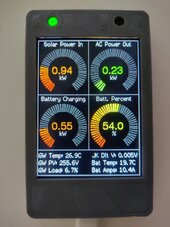thank you @octal_ip for taking the time to create this. Also, thanks to @not-batman (#18) for the idea to use a pi. I used a pi 3b with the PL011 (https://www.abelectronics.co.uk/kb/article/1035/serial-port-setup-in-raspberry-pi-os).. Previously I had tried an FTL232 and a cheap 2102, neither could flash the esp07 successfully, but the pi had no issues.
Just a side note for anyone needing to use octal_ip firmware with an older version of influxdb (like w/ a 32bit os), comment out the line calling the influxdb client like this:
Again, thanks to octal_ip for creating this. It is so nice to have my data flowing directly to my local server instead of the growatt servers.
Just a side note for anyone needing to use octal_ip firmware with an older version of influxdb (like w/ a 32bit os), comment out the line calling the influxdb client like this:
and replace it with this://InfluxDBClient InfluxDBclient(SECRET_INFLUXDB_URL, SECRET_INFLUXDB_ORG, SECRET_INFLUXDB_BUCKET, SECRET_INFLUXDB_TOKEN);
and add this to secrets.hInfluxDBClient InfluxDBclient(SECRET_INFLUXDB_URL, SECRET_INFLUXDB_DB_NAME);
#define SECRET_INFLUXDB_DB_NAME "growatt"
Again, thanks to octal_ip for creating this. It is so nice to have my data flowing directly to my local server instead of the growatt servers.



